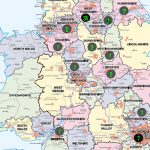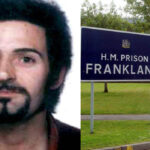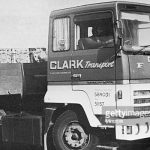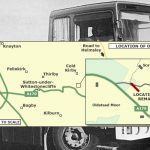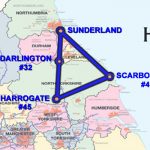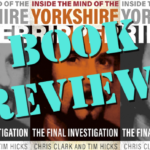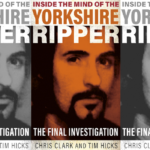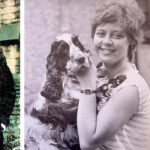The Ripper’s London Attacks #9: Clusters & Routes
Following on from the death of “Yorkshire Ripper” Peter Sutcliffe, in a ground-breaking series of articles, CHRIS CLARK & TIM HICKS now cover his attacks in London and the surrounding area.
~~~~~
The Ripper’s London Attacks #9
by TIM HICKS & CHRIS CLARK
Introduction
Until now, the conventional wisdom was that all of Sutcliffe’s attacks were launched from his car. Chris Clark however was convinced that this was not so. Witness evidence received in the murder of “Hope” in the “Nude in the Nettles” murder in North Yorkshire, the abduction of two girls by Sutcliffe from London in 1977 or 1978 and the attempted abduction of a schoolgirl in Leicester in 1980 has confirmed that Sutcliffe used his lorry to attack women, not just his car.
The murders the authors believe were committed while Sutcliffe was driving his lorry are covered in the following articles:
- The Ripper’s Lorry Murders Part 1. Bedgebury Forest Woman
- The Ripper’s Lorry Murders Part 2. Ilkley: Proof positive
- The Ripper’s Lorry Murders Part 3. More ligature killings
- The Ripper’s Lorry Murders Part 4. Doncaster and Sheffield
- The Ripper’s Lorry Murders Part 5. Bristol, Sussex and Essex
- The Ripper’s Lorry Murders Part 6. “Hope”: More information
- The Ripper’s Lorry Murders Part 7. Leicester and Nottingham
- The Ripper’s Lorry Murders Part 8. Hammersmith and Leicester
In the London articles in the Lorry Murders series, the authors give the background and more information on the eleven murders, (Jacqueline Ansell-Lamb, Barbara Mayo, Gloria Booth, Eve Stratford, Lynne Weedon, Margaret Lightfoot, Elizabeth Parravicini, Lynda Farrow, “Margaret” known as “Bedgebury Forest Woman”, Sally Shepherd and Patricia Morris) one attempted murder (Marie Burke) and two abductions (Child A and Child B) in London the authors believe Sutcliffe should be considered as a suspect for.
The murders of Lucy Tinslop and Judith Roberts, and attempted abduction of Child C have been included because the authors believe they were committed while travelling from London to Bradford.
The murder of Wendy Sewell in Bakewell in 1973 has been included because it has been linked to the murders of Jacqueline Ansell-Lamb and Barbara Mayo.
One murder in Essex (Kay O’Connor in Colchester in 1974) and the murder of an unidentified woman in Norfolk known as “Cockley Cley Woman” are included because the authors believe Sutcliffe committed them while staying with his sister in Duxford. In accordance with their custom when dealing with unidentified victims, the authors have assigned “Cockley Cley Woman” the name ‘Jane‘.
Two other murders have been included because the authors believe Sutcliffe committed them while driving to and from his home in Bradford to Duxford or London. These are Rosina Hilliard in Leicester in1974 and Carolyn Allen in Nottingham in 1974. The murder of Alison Morris in September 1979 at Ramsey in Essex has been included for completeness because of its proximity to Duxford and London.
Attacks the authors believe were conducted using a car are also included in these articles to give a comprehensive picture of the Ripper’s offending in London. For this reason the last articles in the series are called The Ripper’s London Attacks.
Background: Sutcliffe’s access to vehicles
Sutcliffe always had an interest in vehicles and started driving early. In 1963 aged fourteen he was charged with driving whilst only having a provisional licence. As an adult he occasionally worked in a garage as a mechanic, changed cars frequently and -according to his workmates- often fitted his cars with false number plates.
Sutcliffe was made redundant in 1975 and used the redundancy money to finance HGV driver training around Harrogate, Keighley and the nearby village of Silsden. All of which the authors believe were to be the scene of Ripper attacks.
Sutcliffe got his HGV licence on the 4th of June 1975. Sutcliffe then started employment as a lorry driver on the 29th of September of 1975 working first for the Common Road Tyre Company, at Okenshaw, then for T & WH Clark in Bradford, in September 1976 until his arrest in 1981.
The authors have established, through eyewitnesses, that Sutcliffe used his lorry to attack women. It was a perfect cover. He was alone, unsupervised; his driving took him all over the country giving him the opportunity to pick up hitch-hikers. The sleeping area in the back of the cab meant he could stay out overnight in lorry parks and he could also entice women into his cab to have sex. They believe these advantages featured heavily in his decision to become an HGV driver.
Background: Sutcliffe’s travelling and access to London, 1970 – 1980
Peter Sutcliffe did not just confine his travels to West Yorkshire and the surrounding area. He enjoyed driving. Sutcliffe would regularly collect his brother Mick in the lorry and they would go off for two or three days at a time whilst Sutcliffe was delivering and collecting for his firm.
Peter Sutcliffe would regularly be away from home 3 nights a week and return during the afternoon of the fourth day. As an example, Sutcliffe’s mother died of heart disease on 8th November 1978, at the age of 59 years. The following day, Sutcliffe went in his lorry on an overnight run with his youngest brother, Carl. On the return journey, they visited their sister Anne in Morecombe.
Sutcliffe lived in London for some time and had many reasons to visit there in the period 1967 to the time of his arrest in 1981.
1967 – 1971
- Sutcliffe met his future wife Sonia (nee Szurma) in 1967. She had a sister Marianne, who moved to London in about 1966. Peter Sutcliffe visited his future sister-in-law Marianne at Alperton near Wembley off the A406 North Circular Road from 1967 onwards.
- In 1969, Marianne became a graduate member of the Royal Academy of Music. There are anecdotal reports that Sonia and Peter Sutcliffe attended her piano recitals and then Peter drove back to Yorkshire on his own.
- Sonia trained to be a teacher at the Rachel McMillan Teacher Training College in Deptford from September 1970 until mid-1972. At first she lived in a dormitory with a strict “no men” policy. When visiting Sonia in London, Sutcliffe slept in his car or used a small tent pitched on waste ground to camp out. Later Sonia lodged with her sister Marianne and Peter Sutcliffe visited her in London most weekends.
- For the first few weeks of the autumn of 1970, Peter Sutcliffe drove up and down the M1 to spend weekends with Sonia in London, staying at Marianne’s home in Alperton. He then moved to London, taking occasional jobs as a mechanic at a garage in Deptford South East London, while he lived in bed and breakfast accommodation or a bedsit. He worked itinerantly in Yorkshire and Deptford until the end of 1971. By his own account Sutcliffe lived in London for about a year.
- Sutcliffe had an additional reason to visit London. He was very fond of his sister in law Marianne. According to his brother-in-law Robin Holland at Sutcliffe’s trial in 1981, Sutcliffe carried a photograph of Marianne clad only in her underwear in his wallet. The nature of his relationship with her is unclear. It is also unknown if he visited Marianne on his own without Sonia.
- At the end of 1971 Sutcliffe left London and returned to Bradford to work in a factory.
1972 – 1975
- In mid-April 1972 after the Easter holiday, Sonia started her summer term at the Rachel McMillan Teacher Training College. No doubt Sutcliffe drove his wife down the M1 to London beforehand and returned the next day. The same day Marie Burke was abducted from the M1 in London, attacked and left for dead in St Albans.
- In May 1972, Sonia left the Rachel McMillan Teacher Training College in Deptford. She was suffering from mental illness and spent some time in hospital. First in Bexley South East London, then in Yorkshire. During May and June Sutcliffe travelled from Bingley along the M1 to see her in Bexley. In June 1972 Judith Roberts was murdered in Wigginton near Tamworth, just off the M1. Sutcliffe was able to do what he pleased at this time from 1972 to sometime in 1973. His evenings and weekends were free to travel and visit the red light districts in West Yorkshire. In April 1973 Sutcliffe started working night shifts leaving the days free, only visiting Sonia in hospital on weekends. His movements at this time are completely unknown.
- Peter Sutcliffe worked as a furnace man at Anderton International in Bingley from April 1973 until taking redundancy in February 1975. During this time there was a “three-day Week” from 31 December 1973 until early March 1974 due to industrial unrest. This meant that for two days a week there was no work because rota electricity cuts were enforced caused by a shortage of coal. Sutcliffe would certainly have been on short time or been laid off from his job, which depended on coal. This would have given Sutcliffe far more time to roam and go further afield. Again, his movements at this time are completely unknown.
- Peter Sutcliffe’s sister Maureen had been seeing Robin Holland from Keighley who was a serving soldier. On the 3rd of March 1973 she married him at Worth Valley Register Office. He was stationed at Waterbeach Barracks situated between Ely and Cambridge in Cambridgeshire, then later at Barracks in Colchester. They moved to married quarters at Whitehall Gardens, RAF Duxford in Cambridgeshire and Maureen gave birth to a boy at the RAF Hospital in Ely on the 1st of April 1974. Sutcliffe would visit the family regularly, sometimes from Bradford, sometimes from his sister-in law Marianne’s home in Alperton, before returning direct to Bradford. Sometimes he would be with his wife Sonia, sometimes alone. The route between his sister-in law’s home at Alperton and his sister’s home at Duxford would take Sutcliffe across London to the A1M and then on to Duxford. His route from Bradford to Duxford would use the M1 crossing over to the A1. His return journey to Bradford would be via the A1. This would make the Midlands easily accessible to him. Robin and Maureen Holland stayed at Whitehall Gardens before moving to army married quarters in Germany in 1975.
- Peter Sutcliffe married Sonia on Saturday the 10th of August, 1974 which was her 24th birthday. The happy couple went on a short honeymoon to Paris. They stopped at the Duxford home of Robin and Maureen Holland on either the 10th or 11th of August. It is unknown how long they stayed with them for. This ties in with the murder of “Cockley Cley Woman” an unidentified body dumped in the countryside in Norfolk, who is still unidentified to this day.
1975 – 1981
- Sutcliffe started work as a lorry driver from September 1975 until his arrest in 1981. He is known to have made deliveries in Essex and London. Sutcliffe had an extensive collection of A-Z guides of many cities, delivered to London regularly and had lived there. In short he knew London very well and could easily navigate his way around it. One witness has come forward and stated that when he was working in London, Sutcliffe drank regularly in the Conquering Hero pub at 262 Beulah Hill, London SE19 3HF. The authors believe this would have been between 1976 and 1980.
- During 1977 and 1978 Sutcliffe’s wife Sonia frequently went to stay with her Sister Marianne and her family in Alperton. Peter Sutcliffe would take her there and collect her afterwards in his car. She may also have travelled down to London in his lorry if he had a drop there.
- In 1977 or 1978, Sutcliffe abducted two schoolchildren aged thirteen or fourteen from Hammersmith in his lorry and released them in Sunderland. This new evidence was uncovered by Chris and is of crucial importance, because it established that Sutcliffe was committing serious offences in London using his lorry.
- In 1979, a woman was murdered in North Yorkshire. Her body was discovered in 1981 and she was never identified. A witness came forward to the NYE with an identity for the victim and confirming she was a prostitute that lived in Scarborough. He also confirmed that Sutcliffe delivered to Scarborough in his lorry and frequented a café opposite the bus shelter where this woman plied her trade.
- Sutcliffe regularly delivered to London, particularly to the LEP Depot in Charlton.
Sutcliffe spent long periods in London and travelling to and from London. He was alone for most of these journeys. There were no tachographs at this time and his record of hours driving would have been handwritten by Sutcliffe. It is therefore clear that he had the opportunity to visit London on his own and cruise around, and there is no way of knowing where he was or what he was doing.
Sutcliffe enjoyed using prostitutes. After he had finished visiting Sonia and Marianne, he could move around in London on his own and pick up prostitutes at Soho, Shepherds Market, Commercial Road and/or Spitalfields, before driving home in his car up the M1. When he was in his lorry, Spitalfields is a more likely pick-up point. It was normal for lorries to deliver there, so he did not stick out and it had manoeuvring space.
Cluster and Route Analysis
Sutcliffe’s modus operandi ensured that he always worked from a vehicle and had easy access to an escape route on a fast road, preferably an A-road leading to a motorway.
The authors have utilised some very effective graphic work by Nigel Ward, to correlate attacks they believe were perpetrated by Sutcliffe but never attributed to him, with routes and locations he is known to have frequented. This is the first time geographical analysis of this type has ever been performed on Peter Sutcliffe’s movements.
Sutcliffe’s attacks were previously known to fall into a series of known clusters around red light districts in Leeds, Bradford, Halifax, Manchester and Huddersfield, as shown between the photo-fits in the lead illustration. This new analysis presents a more detailed picture.
Attacks committed prior to the 29th of September of 1975, when he got his first job as a lorry driver, were committed in his car or, on one occasion, in a friend’s car. Thereafter, they were committed using his lorry or his car. The authors believe that he only used his lorry for some routes in the period 1975 to 1980:
- Bradford to and from Scarborough.
- Bradford to and from Harwich.
- Bradford to and from LEP Depot Charlton.
- London to and from Sunderland
The remainder he used in his lorry for work in the period 1975 to 1980 and his car socially, during the period 1969 to 1980.


Murders along routes not associated with London
Route 1: Bradford to and from Harwich: Murder of Alison Morris in September 1979 (28) at Ramsey in Essex, probably on the return journey to Bradford using the A120, M111, A14, A1M route to Bradford. It was covered in this NYE article.
Route 2: Bradford to and from Scarborough via M1, M62 and A64: Attempted abduction of two women in York in June 1980 (27), covered in this NYE article. Murder of “Hope” or the “Nude in the Nettles” in August 1979 (25); return via A170 to conceal the body more easily. It was covered in this NYE article and the authors have linked it to the murder of “Jane” or “Cockley Cley Woman” (22) in Norfolk in August 1974. Attempted abduction of two women in York. NYE article here.
Route 3: Bradford to and from Brighton: M62 M1, A406, A10, A202, A23: Murder of Margaret Frame (23) in October 1978 at Brighton. It was covered in this NYE article.
Route 4: Bradford to and from Sunderland Docks using the M1, M62, A1(M), A19 route: Murder of Stephanie Spencer in Darlington in May 1977 (26) which is covered in this NYE article. Attempted murder of a sixteen year old schoolgirl at Harrogate in February 1979, covered in this NYE article.
These murders are not in London or on the journey to or from London and are included here for completeness. However, the following groupings of attacks were mounted in London, or during the journey to and from London, or have been connected to London attacks:
Murders along routes between Bradford and Sutcliffe’s sister-in-law Marianne’s house at Alperton (Car and Lorry):
Route 5: Route home to Bradford from Sutcliffe’s sister-in-law Marianne’s house at Alperton using the M1 M62 with a diversion via the A453 and A60 to Bath Street, Nottingham return to the M1 via the A60, A6130 and A610: Murder of Lucy Tinslop August 1969 Nottingham.
Route 6: Direct route home to Bradford from Sutcliffe’s sister-in-law Marianne’s house at Alperton using the M1 M62: Barbara Mayo abduction from the M1 (2) and deposition (15) site in October 1970.
Route 7: Route home to Bradford from Sutcliffe’s sister-in-law Marianne’s house at Alperton with a diversion from the M1, A42, A444, or M42 A5, B5000, A513 to Wigginton, Tamworth Staffs, then returning to the M1 via B4593 and A42: Murder of Judith Roberts (17) in June 1972,
Route 8: Route home to Bradford from Sutcliffe’s sister-in-law Marianne’s house at Alperton via the M1 using the A14 crossover to the A1(M): M1, A414, A1M, M62: Marie Burke abduction from the M1 (4) and deposition (16) sites in April 1972.
Route 9: Route home to Bradford from Sutcliffe’s sister-in-law Marianne’s house at Alperton via Manchester, using the M1, M6, or M1, A50, M6; then M50, M62: Jacqueline Ansell-Lamb abduction from the M1 in March 1970 (1) and deposition (14) sites.
Route 10: Western route home from Sutcliffe’s sister-in-law Marianne’s house at Alperton using the A40, M40 and M1: Murder of Gloria Booth in June 1971 (3).
Route 11: Route home to Bradford from Sutcliffe’s sister-in-law Marianne’s house at Alperton using the M1 M62 with a diversion via the A563 to Checketts Road returning to the M1 along the A563 and A50: Attempted murder of Child C in April 1980 from Checkett’s Road Leicester (Also 19).
Abductions from London on the route to and from Sunderland Docks
Route 12: London to Sunderland Docks, M1 or A1(M) A19: Abduction of Child A and Child B (Lorry) from Hammersmith London deposited in Sunderland in 1977 or 1978.
Cluster of murders in South West London
Route 13: South Western route home to Bradford from Sutcliffe’s sister-in-law Marianne’s house at Alperton using the A4, M4, M25 and M1: Murders of Lynne Weedon in September 1975 (6), Elizabeth Parravicini in September 1977 (7) and Patricia Morris in June 1980 (10).
Cluster of murders around the LEP Depot at Charlton
Route 14: Bradford to the LEP Depot at Charlton (Lorry) using the M62, M1, A406 North Circular Road, A10, A2: Abduction of “Margaret” or “Bedgebury Forest woman” in October 1979 (12), or (13), and murder at Bedgebury Forest (24). Chris has established that Sutcliffe delivered in Europe and it is possible that he drove to the continent via Dover. If so, then the deposition site at Bedgebury Forest may be associated with the onward route to Dover using the M2 or M20 via Bedgebury Forest, then on to Dover using the A20. Murder of Sally Shepherd (9) in December 1979 is in this area which Sutcliffe knew very well. Abduction of Child A and Child B from Hammersmith may have been on the return journey to Sunderland from the LEP Depot.
Cluster of murders along the route from Sutcliffe’s sister-in-law Marianne’s house at Alperton to his Sister Maureen’s home in Duxford:
Route 15: Eastern route to leave Marianne and visit Maureen using the A406 North Circular Road and M11: Lynda Farrrow in January 1979 (8), Eve Stratford in March 1975 (5) and Margaret Lightfoot (11) in November 1975.
Cluster of murders associated with Sutcliffe’s sister Maureen’s home at Duxford
The authors believe that:
- Kay O’Connor was murdered in March 1974 in Colchester, by Sutcliffe after he had visited his sister Maureen and brother in law Robin Holland in Duxford, (Robin was a soldier stationed at Colchester), or while driving through Colchester to go to/return from Clacton on Sea.
- “Jane” or “Cockley Cley Woman” (4) was murdered between the 7th and 14th of August 1974 in Norfolk by Sutcliffe, who was staying with his sister Maureen at Duxford, one hours drive away from the deposition site via the A11 at the time.
The murder of Alison Morris in September 1979 at Ramsay in Essex was probably committed on the return journey to Bradford from Harwich Docks for Sutcliffe’s work and not associated with Duxford or Sutcliffe’s Sister Maureen. It is included for completeness only.
The authors also believe that the following murders were committed while travelling between Bradford and Duxford:
Route 16: Murder of Wendy Sewell (1) in September 1973, by taking a short detour off the M1 to Bakewell, using the A6, A619, A621, A6102 and A630.
Route 17: Murder of Rosina Hilliard (2) in February 1974 in Leicester just off the A47 using the A47 to crossover between the A1M to the M1 through Leicester to return to Bradford from Duxford.
Route 18: Abduction of Carolyn Allen in April 1974 (3) in Nottinghamshire, body hidden at Old Dalby Wood Leicestershire while using the A 46 and A606 to crossover between the A1M and the M1 to go through Nottingham on the way to or from Duxford to or from Bradford.
It is also possible that the murders of Carolyn Allen, Rosina Hilliard and Wendy Sewell were committed from the M1 or A1(M)/A1 on a journey to or from London, but the authors feel it is more likely they were committed on the journey to and from Duxford.
Structure of the Articles
The Ripper’s London attacks 9:
-
- Cluster analysis
- Routes
- Access to vehicles
- Access to London
The Ripper’s London attacks 10: The M1 Hendon abductions
-
- Jacqueline Ansell-Lamb. 03/70 Returning to Bradford from Alperton
- Barbara Mayo. 10/70 Returning to Bradford from Alperton
The Ripper’s London attacks Part 11: The Western and South Western routes
-
- Gloria Booth 06/71 Returning to Bradford from Alperton
- Elizabeth Parravicini 09/77 Returning to Bradford from Alperton
- Patricia Morris 06/80 Returning to Bradford from Alperton
The Ripper’s London attacks 12: The Northern route 1
-
- Child C 1980 Returning to Bradford from Alperton
- Marie Burke 04/72 Returning to Bradford from Alperton
The Ripper’s London attacks 13: The Northern route 2
-
- Lucy Tinslop 08/69 Returning to Bradford from Alperton
- Judith Roberts 06/72 Returning to Bradford from Alperton
The Ripper’s London attacks Part 14: The South Eastern cluster
-
- Child A and Child B 1978 or 1979 Delivering to the LEP Depot
- Margaret”/“Bedgebury Forest woman” 10/74 Delivering to the LEP Depot/Dover
- Sally Shepherd 12/79 Delivering to the LEP Depot
The Ripper’s London attacks 15: The Eastern route and Weedon Links
-
- Eve Stratford 03/75 Travelling from Alperton to Duxford
- Lynda Farrow 01/79 Travelling from Alperton to Duxford
- Lynne Weedon. 09/75 Returning to Bradford from Alperton
(These are grouped because they have been linked by the police)
The Ripper’s London attacks 16: The Eastern route 2
-
- Margaret Lightfoot 11/75 Travelling from Alperton to Duxford
The Ripper’s London attacks 17: The Duxford Cluster 1
-
- Rosina Hilliard 02/74 Travelling between Duxford and Bradford
- Kay O’Connor 03/74 Staying at Duxford
The Ripper’s London attacks 18: The Duxford Cluster 2
-
- Carolyn Allen 04/74 Travelling between Duxford and Bradford
- Alison Morris 09/79 Returning to Bradford from Harwich
The Ripper’s London attacks 19: The Duxford Cluster 3
-
- “Jane” 08/74 Staying at Duxford
The Ripper’s London attacks 20: The Duxford Cluster 3
-
- Wendy Sewell 09/73 Travelling between Duxford and Bradford
- The linking of the cases.
The Ripper’s London attacks 21: The antecedent investigations
-
- Why the police failed to link the cases during the 1981 Byford antecedent investigation, the Hellawell 1982 – 1992 antecedent investigation and subsequent cold case investigations.
The vehicles the authors believe the Ripper used are shown in Column F “Vehicle Used” in Table 13, below.




